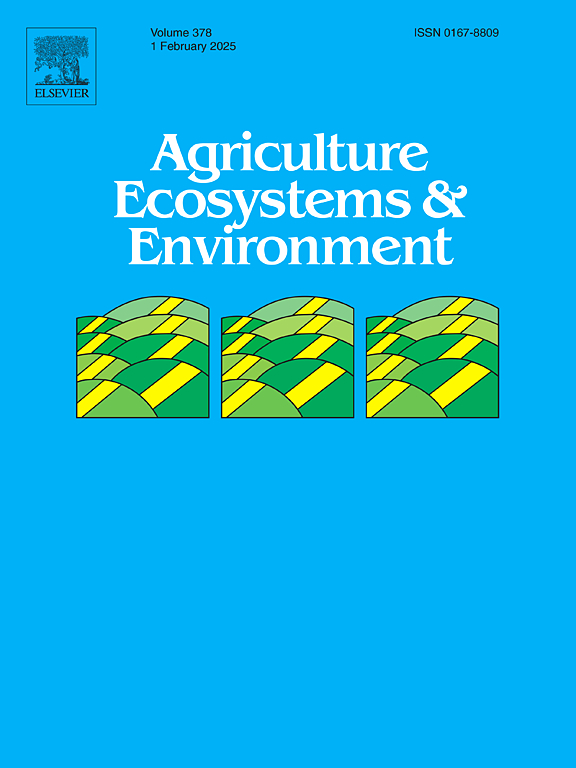季节性放牧对高寒草甸土壤酶、理化性质及植被的影响
IF 6
1区 农林科学
Q1 AGRICULTURE, MULTIDISCIPLINARY
引用次数: 0
摘要
青藏高原高寒草地对区域生物多样性和养分循环至关重要,但放牧退化对高寒草地的影响日益严重。研究了春、夏、秋、冬四季放牧对青藏高原高寒草甸土壤胞外酶活性、主要理化性质和植物生物量的影响。在连续两年(2021-2022年)的时间里,在重复的季节性放牧样地收集放牧前和放牧后的土壤和植被样本。分析了优势功能类群:苏柏科、禾本科、豆科和杂禾本科的酶活性与生物量的关系。酶按功能分为营养循环酶(磷酸酶、羟胺还原酶)、有机物降解酶(淀粉酶、纤维素酶、几丁质酶、葡萄糖苷酶、多酚氧化酶)和蛋白质水解酶(碱性蛋白酶)。结果显示酶活性和植物生物量有明显的季节变化规律。淀粉酶(3066 μgd−1g−1)和羟胺还原酶(466 μgd−1g−1)活性在冬牧期间显著提高(p <;几丁质酶(40 μgd−1g−1)和纤维素酶(675 μgd−1g−1)在春季达到峰值。夏季放牧时葡萄糖苷酶活性最高,而碱性蛋白酶的季节变化最小。植物生物量随季节变化,冬季以莎草科为主,秋季以禾本科为主,夏季以杂禾本科为主,豆科生物量保持较低水平。Pearson相关分析显示,淀粉酶升高之间存在显著相关性(p <;0.05)和羟胺还原酶(p <;0.01)活性随苏科生物量的增加而增加。同样,几丁质酶活性较高(p <;0.01)与杂草生长呈正相关。这些研究结果表明,季节性放牧改变了土壤酶活性,影响了植物生长和物种组成,并强调了适应性放牧策略对维持高寒草甸土壤健康和生态系统恢复力的必要性。本文章由计算机程序翻译,如有差异,请以英文原文为准。
Impacts of seasonal grazing on soil enzymes, physicochemical properties, and vegetation in alpine meadows
Alpine grasslands of the Qinghai–Tibet Plateau (QTP) are vital for regional biodiversity and nutrient cycling but are increasingly affected by grazing-induced degradation. This study examined the effects of seasonal grazing (spring, summer, autumn, winter) on soil extracellular enzyme activities, key physicochemical properties, and plant biomass in alpine meadows of the QTP. Over two consecutive years (2021–2022), pre- and post-grazing soil and vegetation samples were collected from replicated seasonal grazing plots. Enzyme activities were analyzed in relation to biomass of dominant plant functional groups: Cyperaceae, Poaceae, Leguminosae, and miscellaneous grasses. Enzymes were categorized by function into nutrient cycling (phosphatase, hydroxylamine reductase), organic matter degradation (amylase, cellulase, chitinase, glucosidase, polyphenol oxidase), and proteolysis (alkaline proteases). The results revealed distinct seasonal patterns in enzymatic activity and plant biomass. Amylase (3066 μgd−1g−1) and hydroxylamine reductase (466 μgd−1g−1) activities were significantly higher during winter grazing (p < 0.05), while chitinase (40 μgd−1g−1) and cellulase (675 μgd−1g−1) peaked during spring. Glucosidase activity was highest under summer grazing, while alkaline proteases exhibited minimal seasonal variation. Plant biomass varied by season: Cyperaceae dominated in winter, Poaceae in autumn, and miscellaneous grasses in summer, whereas Leguminosae biomass remained consistently low. Pearson correlation analysis showed significant correlations between elevated amylase (p < 0.05) and hydroxylamine reductase (p < 0.01) activities with increased Cyperaceae biomass in winter. Similarly, higher chitinase activity (p < 0.01) during spring was positively correlated with the growth of miscellaneous grasses. These findings reveal that seasonal grazing alters soil enzymatic activity, influencing plant growth and species composition, and underscore the need for adaptive grazing strategies to sustain soil health and ecosystem resilience in alpine meadows.
求助全文
通过发布文献求助,成功后即可免费获取论文全文。
去求助
来源期刊

Agriculture, Ecosystems & Environment
环境科学-环境科学
CiteScore
11.70
自引率
9.10%
发文量
392
审稿时长
26 days
期刊介绍:
Agriculture, Ecosystems and Environment publishes scientific articles dealing with the interface between agroecosystems and the natural environment, specifically how agriculture influences the environment and how changes in that environment impact agroecosystems. Preference is given to papers from experimental and observational research at the field, system or landscape level, from studies that enhance our understanding of processes using data-based biophysical modelling, and papers that bridge scientific disciplines and integrate knowledge. All papers should be placed in an international or wide comparative context.
 求助内容:
求助内容: 应助结果提醒方式:
应助结果提醒方式:


